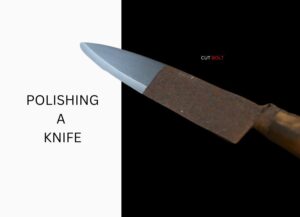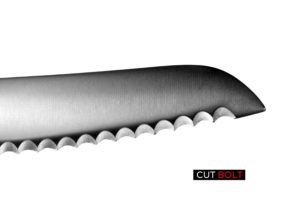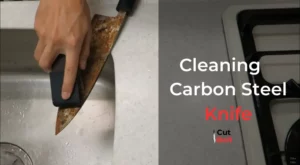Discover the secret to unlocking the razor-sharp potential of your ceramic knife. Are you wondering, “How do you sharpen a ceramic knife?”
Look no further. In this guide, we’ll unravel the mystery behind achieving a fine, enduring edge on your ceramic blade. Whether you’re a seasoned chef or a kitchen novice, prepare to uncover the art of honing perfection.
So, how to sharpen ceramic knife? Get ready to slice through challenges with unparalleled precision.
Table of Contents

Can you sharpen a ceramic knife at home?
Ceramic knives have become increasingly popular due to their long-lasting sharpness and resistance to corrosion. However, their unique material requires a different approach to sharpening compared to traditional steel knives. Learn the differences between steel knives and ceramic knives.
So, if you are wondering, can you sharpen a ceramic knife? The answer is slightly complex.
Indeed, most of them have a very high hardness. Which makes them extremely sharp but also more fragile than steel knives. Due to this fragility, their sharpening can be more delicate and require specific tools. You should know the pros and cons of a ceramic knife.
Here are some things to consider before you start sharpening ceramic knives:
- Professional sharpening: It’s best to let professionals handle the sharpening of ceramic knives. They have the skills and tools needed to do it carefully and correctly. You can find this service at specialty stores or from knife makers.
- Home sharpening: If you really want to sharpen your ceramic knife at home, there are some things to keep in mind. However, it’s important to note that there are limits to how much you can sharpen it yourself. We’ll provide more details in the article below.
- Hand sharpening: Traditional sharpening methods used for steel knives, like whetstones, generally won’t work well with ceramic knives due to their hardness.
- Precautions to take: When sharpening a ceramic knife at home, be cautious and gentle. Apply minimal pressure and avoid sudden movements that could damage the blade.
- Blade replacement: Sometimes, if the blade is dull or significantly damaged, it may be better to replace it rather than attempt to sharpen it. Some manufacturers offer a replacement service, which can be a practical solution to maintain the sharpness of your knife.
Sharpening ceramic knives can be challenging. While it’s advised to let professionals handle it, some owners prefer sharpening at home with specialized tools. In either case, it’s crucial to exercise caution and follow the recommendations below to maintain the durability and sharpness of your ceramic knife.
Five methods to sharpen a ceramic knife at home:
Ceramic blade knives are known for their incredibly sharp edges that can last a very long time. However, even though they are durable, there may come a time when the blade chips or becomes dull.
In such cases, you’ll need to sharpen the knife. There are three methods for sharpening ceramic knives, ranging from the easiest to the most challenging.
Here are the 5 methods of sharpening ceramic blades:
Method 1: Using an electric knife sharpener:
Before you start sharpening keep the following things in mind:
- Select a suitable electric knife sharpener: Look for an electric sharpener specifically designed to handle ceramic knives. Make sure it is compatible with ceramic blades.
- Read the manufacturer’s instructions: Familiarize yourself with the specific guidelines provided by the sharpener’s manufacturer. Each sharpener may have its unique operating instructions.
- Prepare the sharpener: Set up the electric sharpener on a stable surface, ensuring it is securely placed. Plug it into a power source.
- Adjust the angle: Most electric sharpeners have adjustable angle settings. Consult the instructions to determine the correct angle for sharpening ceramic knives. Set the sharpener to the appropriate angle.
- Safety first: Wear protective gloves to ensure your hands are shielded during the sharpening process. This will help prevent accidental injuries.

Sharpening a ceramic knife with an electric knife sharpener:
- Step1: Begin sharpening: Hold the ceramic knife firmly by the handle and slowly insert the blade into the designated sharpening slot of the electric sharpener. Follow the recommended technique provided by the manufacturer, which may involve sliding the blade back and forth or moving it in a circular motion.
- Step2: Sharpen both sides: Ensure that you sharpen both sides of the blade evenly. Maintain a steady and consistent pressure while guiding the knife through the sharpening slot.
- Step 3: Repeat the process: Depending on the sharpness of your ceramic knife, you may need to repeat the sharpening process multiple times. Check the blade periodically to assess its sharpness and continue until you achieve the desired results.
- Step 4: Test the sharpness: Once you finish sharpening, carefully wipe the blade clean and test its sharpness by gently slicing through a soft object, such as a piece of paper or a tomato. If the knife cuts smoothly and effortlessly, it indicates a successful sharpening.
Method 2: Sharpening a ceramic knife with a diamond sharpener:
Gather the necessary materials: Obtain a diamond whetstone or diamond-coated sharpening rod. Ensure you have at least three different grits available: coarse (around 200), medium (around 600), and fine (1000 or higher). If you can access even finer grits, that’s even better. Additionally, prepare a non-slip surface, such as a damp towel or rubber mat, to place the whetstone or rod on during sharpening.
Prepare the diamond sharpener: Place the diamond whetstone or sharpening rod on the non-slip surface, ensuring it remains stable and securely positioned.
Ceramic knife sharpening steps using diamond sharpener:
- Step1: Begin with the coarse grit: If your ceramic knife is very dull or has chips, start with the coarse grit. Hold the diamond sharpener firmly and position the blade at the desired angle (around 20 to 25 degrees). Gradually slide the blade across the sharpening surface, maintaining consistent pressure and using smooth, controlled motions. Repeat this process several times on each side of the blade, alternating the strokes.
- Step2: Progress to the medium grit: Once you have achieved a reasonable level of sharpness with the coarse grit, switch to the medium grit. Follow the same technique as before, repeating the sharpening process on both sides of the blade. This step helps refine the edge and further enhance the sharpness.
- Step 3: Finish with the fine grit: To attain a polished edge and enhance the sharpness even more, move on to the fine grit. Repeat the sharpening process, ensuring equal attention is given to both sides of the blade. This final step contributes to achieving a refined, razor-sharp edge.

Method 3: Sharpening a ceramic knife with diamond rod
Sharpening a ceramic knife using a diamond sharpening rod offers an efficient and effective method. Diamond, being the hardest material available, is capable of sharpening the hardened surface of ceramic knives.
To sharpen your ceramic knife using a diamond sharpening rod, follow these simple steps:
- Ensure that the rod is clean and free from any oil or contaminants that may damage the blade.
- Begin at one end of the blade and slowly draw it along the rod in a sweeping motion.
- Apply gentle downward pressure on both sides of the blade, allowing it to make contact with the abrasive surface of the rod.
- Repeat this process several times until you achieve a smooth and even edge along both sides of the blade. As a general guideline, aim for approximately 8-10 continuous strokes per side. However, adjust the number based on the initial dullness of your knife. Avoid applying excessive pressure, as it can create indentations in the ceramic and potentially harm your knife.
Once you finish using the diamond sharpening rod, carefully inspect both sides of the blade for any burrs or imperfections. If necessary, repeat the sharpening process until you achieve the desired results and a well-sharpened edge on your ceramic knife.
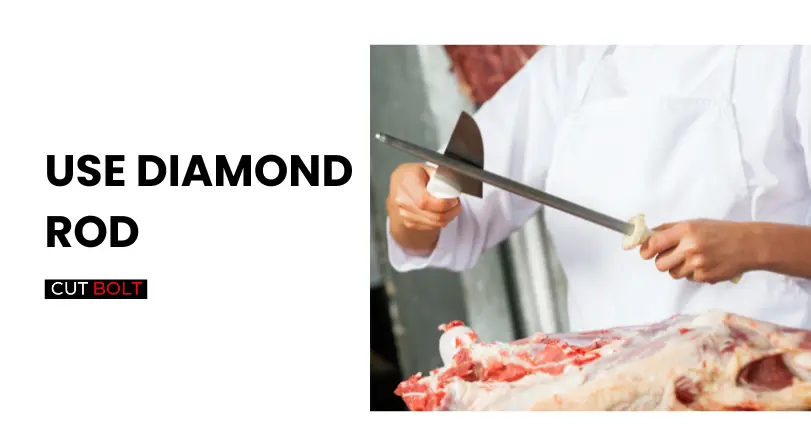
Method 4: Use a Wet Stone to sharpen a ceramic knife
Using a wet stone for sharpening is a traditional and time-tested method to achieve a precise edge. However, it requires some skill and should be approached with caution, especially for beginners.
To use a wet stone, begin by soaking it in water for at least an hour until all air bubbles are gone. Place the stone on a flat, non-slip surface and lubricate it with oil like mineral or vegetable oil. You can also add a piece of leather, cloth, or towel between the stone and its base to prevent slipping.
When ready to sharpen, position the blade with its edge facing down on the wet stone. Apply light pressure and move the blade in circular motions while tilting it against the direction of motion. This ensures equal pressure on both sides of the cutting edge, resulting in uniform sharpening.
Avoid dragging metal shavings to the opposite side of the blade to maintain evenness. Aim for sharpening angles of around 15 to 25 degrees, from tip to spine, on both sides of the blade.
To achieve a perfect edge, perform an even number of finish strokes across the entire blade. This will provide your knife with a sharp edge suitable for any task you have at hand!
Remember, using a wet stone requires practice and patience. Take your time and focus on maintaining consistent angles and pressure to achieve the desired sharpening results.
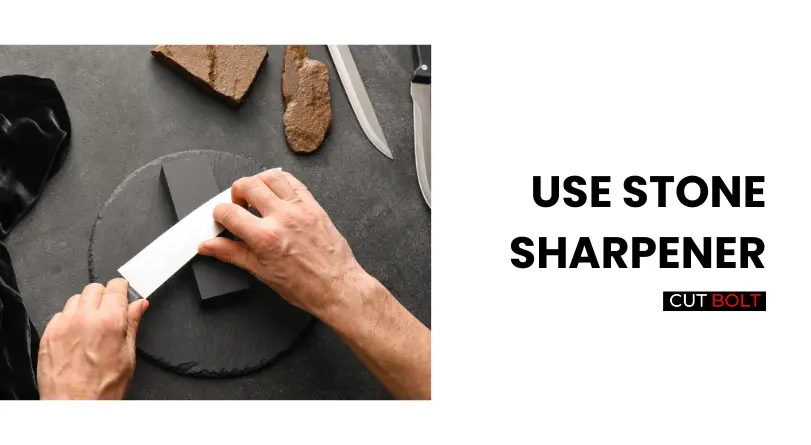
Method 5: Return the knife to the manufacturer to sharpen
Prepare yourself for a rather absurd, yet surprisingly effective method to resurrect your chipped or dull ceramic knife. Brace for impact, because this technique may seem ludicrous to you, but it works like a charm!
Now, hold on tight, because here’s the kicker: it’s a time-consuming process. BUT (and this is a big but), you won’t need to splurge on expensive tools or spend hours mastering a new technique. Plus, it eliminates the peril of accidentally snapping your precious blade.
Oh, and guess what? Your knife might still be under warranty! You won’t believe it, but some manufacturers offer free sharpening services. Yes, you heard that right! Take Böker, for instance. They sharpen their ceramic knives at no cost, except for the postage fee. They’re so generous that they’ll even sharpen a ceramic knife from another brand, though it comes with a small fee.
So, why not tap into their expertise? It’s like having your very own knife-wizard at your disposal. Trust me, it’s an offer you don’t want to miss!
Also, read how to mirror polish a knife by hand if you are using other knives in the kitchen.

Final Thoughts: – How do you sharpen a ceramic knife
Mastering the art of sharpening ceramic knives unlocks a world of precision and efficiency in the kitchen. Whether through professional services or DIY methods, the key lies in understanding the unique requirements of ceramic blades.
By following proper techniques, selecting appropriate tools, and exercising caution, you can restore and maintain the razor-sharp edge of your ceramic knife. Embrace the journey of honing perfection and elevate your culinary experience with every precise slice.

